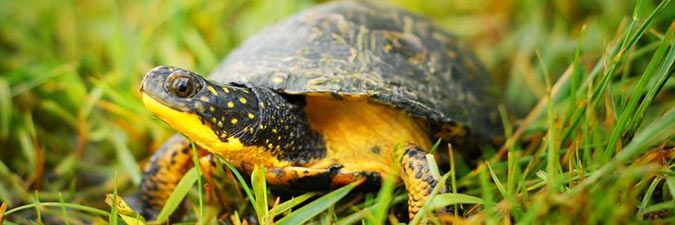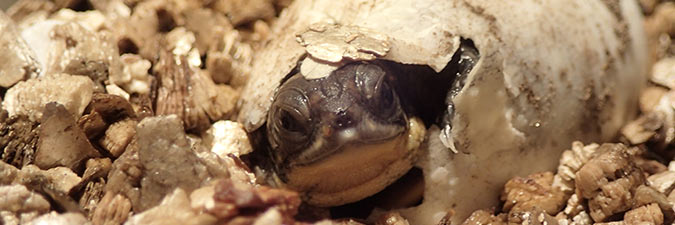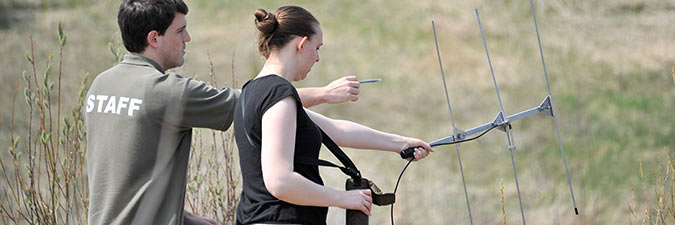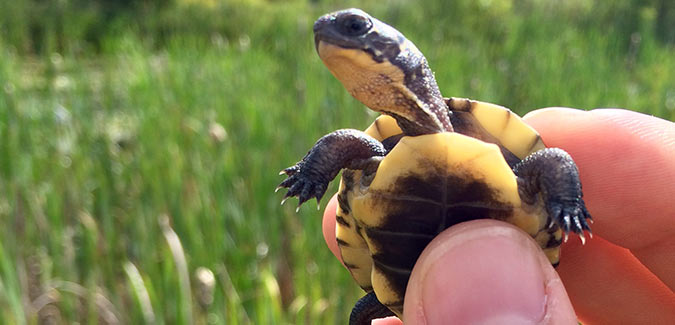Monitoring
Turtles, Snakes, and Frogs in the GTA
We have used radio telemetry to track the movements of Snapping, Northern Map, and Blanding’s turtles in the GTA. Wild turtles are captured and we attach small, temporary tarnsmitters to their shells. After release, the turtles are re-located multiple times each week with the aid of a receiver tuned to the frequency of each turtle’s transmitter. This allows the researchers to “tune in” to each turtle in the same way that we tune in to radio stations in our cars, and to track each individual turtle, one-at-a-time. Tracking urban turtles provides us with important information about their foraging areas, overwintering sites, and nest habitats.
We have also begun monitoring efforts for snakes, namely the eastern milksnake, and frogs, including the chorus frog. These monitoring efforts are concentrated in the GTA, and focus on getting a better understanding of the range of these species in urban environments. Information gained through these monitoring efforts will better inform legislation concerning these species, as well as mitigation measures that are put into place to preserve them.
Monitoring Other Reptiles and Amphibians
We also monitor local and provincial turtle and frog populations by inviting members of the public to report turtle sightings to Ontario Turtle Tally and FrogWatch , respectively. This information helps us to increase our understanding of turtle and frog distribution and ranges far beyond what we would be able to survey ourselves. These locations can be anywhere that the citizen scientist is able to access- parks, local wetland systems, backyards, and beyond! The information submitted to both Turtle Tally and FrogWatch is critical in identifying areas of concern and threats to these species and to ensure that mitigation measures, including turtle and snake crossing signs and Eco Passages are installed in the most worthwhile locations. Last, and certainly not least, these programs are an excellent way to get outside and have fun!
Habitat Assessment
We have surveyed wetlands in specific areas of the GTA to determine how much turtle habitat is available and to locate prime turtle nesting areas. Using a combination of field research and Geographic Information System analysis, we assessed the suitability of specific wetland sites for turtles. With this date, we are able to identify important areas for habitat restoration and places where the construction of ecological corridors can re-link turtle populations that have been separated by development.
Blanding’s Turtle Head-starting and Reintroduction
With support from Parks Canada, the Toronto and Region Conservation Authority (TRCA) and the Ontario Ministry of Natural Resources and Forestry (MNRF), the Toronto Zoo raises and reintroduces juvenile Blanding’s turtles into natural and created wetlands of the Rouge National Urban Park in the Greater Toronto Area. The Rouge National Urban Park is Canada’s first national urban park and one of the largest parks of its kind in the world.

Turtle species worldwide are in decline. Of the 8 native turtle species found in Ontario, 7 are now classified as Species at Risk. Turtles have a long life span and delayed sexual maturity. These life history characteristics mean that populations are highly sensitive to human-induced threats such as habitat loss and fragmentation caused by urban development and drainage of wetlands for agriculture, road mortality, and increased levels of predation due to predators like raccoons that tend to be over-abundant in urban areas.
The Blanding’s turtle, a long-lived species with a life span of up to 80 years, is listed as a threatened species both provincially and nationally. This species has inhabited the Rouge Valley for thousands of years; however, prior to the initiation of the Toronto Zoo’s head-starting program, Blanding’s turtles were facing almost imminent local extinction in this area, with as few as six individuals remaining.
After over a decade of monitoring turtles in (the now) Rouge National Urban Park, the Toronto Zoo’s Adopt-A-Pond Wetland Conservation Programme proposed to supplement the Park's declining Blanding’s turtle population with head-started juveniles as part of a comprehensive approach to species recovery, which also included habitat creation, academic research, stewardship initiatives, and outreach and education programs to save this species from local extinction. With funding from Parks Canada, and project support from the TRCA and the MNRF, Adopt-A-Pond staff were able to release the first group of head-start turtles into the wilds of the Rouge Valley in 2014.

The head-start turtle eggs are collected under permit from stable source populations in Ontario, from at-risk nest sites where eggs would otherwise not survive to hatching. This includes nests from construction sites and tilled farm fields. The eggs are incubated and hatched, and then the hatchlings are raised in a controlled environment at the Toronto Zoo for two years before they’re released back into the wild.
When baby Blanding’s turtles are first born they are very soft and about the size of a loonie, making them an easy meal for any predator that can fit the tiny turtle in its mouth. The Toronto Zoo raises head-starts to about the size of a baked potato. At this point their shells are much harder and they are large enough to evade most predators (like raccoons, skunks, foxes, coyotes and crows), thereby giving them a head-start in life!

Ongoing research and habitat creation are also a big part of the head-start project. Our goal is to release approximately 50 young Blanding’s turtles back into the wild each spring. To keep track of their movement and survival staff from the Toronto Zoo attach tiny radio transmitters to each of their shells. We continue to monitor the turtles as they interact with their new environment and undergo important milestones such as migration and hibernation. The information gained from monitoring these turtles will help to inform us about their habitat requirements and help us to understand what we can do to ensure they are continually provided with suitable areas to live.
The University of Toronto (Scarborough) has now partnered with the project to assist with the long-term monitoring of released Blanding’s turtles. Parks Canada, TRCA, and the Toronto Zoo are also participating in long term habitat improvement projects, including wetland restoration, the creation of nesting habitats, and the construction of road way eco-passages that will promote this species’ long-term survival and sustainability in the Rouge Valley.
A long term partnership with Environment Canada and the Ontario Ministry of Natural Resources and Forestry has greatly enhanced the Blanding’s turtle monitoring and head-start project by providing funding, permits and in-kind contributions to conduct research on wild Blanding’s turtles in the Rouge Valley. Earth Rangers, an environmental conservation organization focused on engaging youth in the protection of nature, has provided support for the project by building a facility to house the turtle eggs and hatchlings at the Toronto Zoo.

Blanding’s turtles are an excellent species upon which to model wetland protection initiatives. Blanding’s turtles use a variety of different wetland habitats throughout their life cycle, including swamps, marshes, ponds, vernal pools and connecting travel corridors like ravines and rivers. Protecting Blanding’s turtles and their habitat goes a long way to benefit other native turtles, birds, fish and amphibians that use the same wetland homes. Together, we can focus on saving habitat for one species to save an entire ecosystem!
